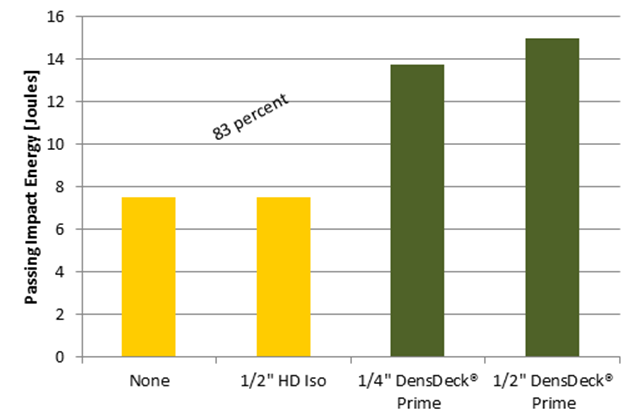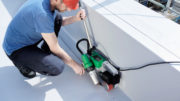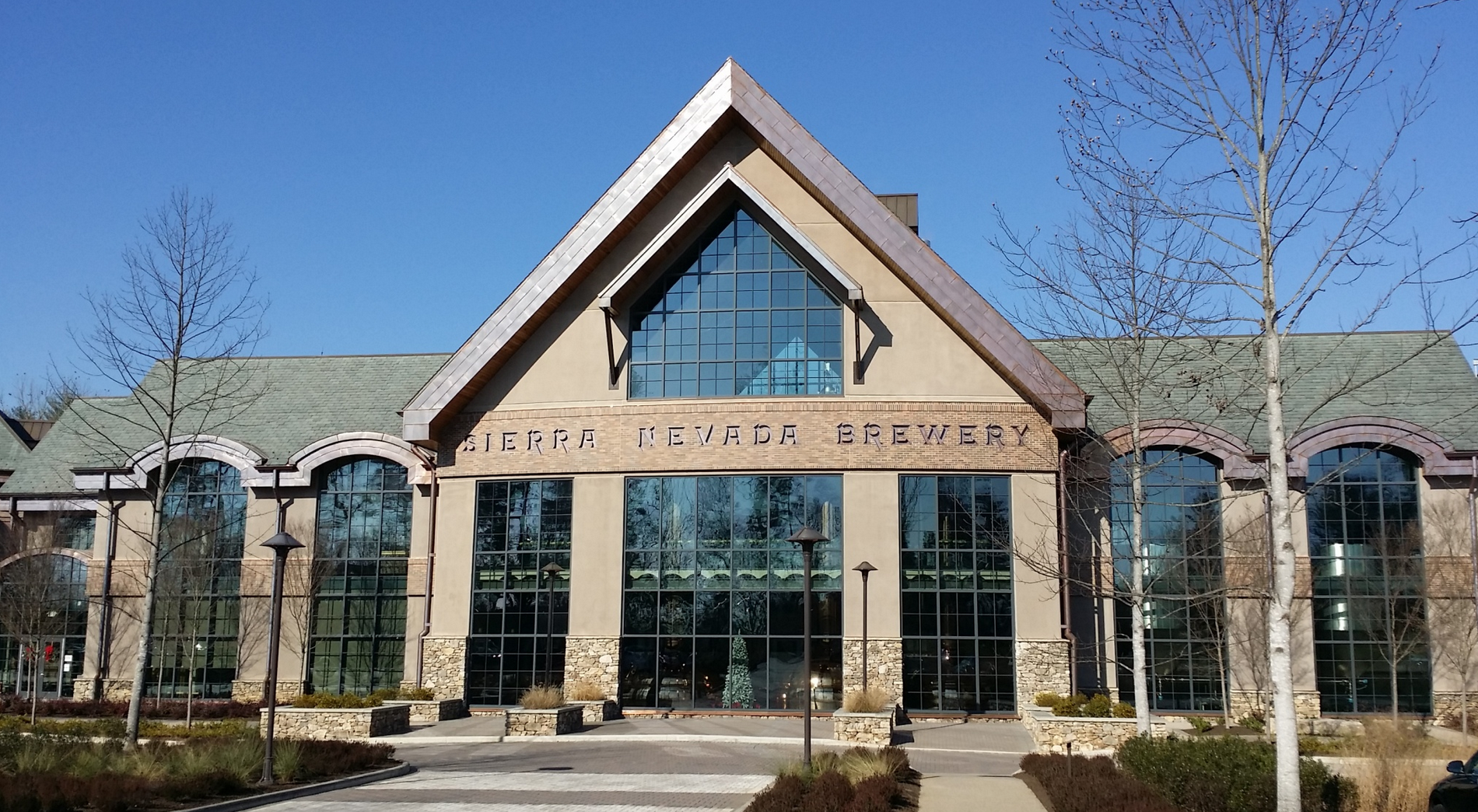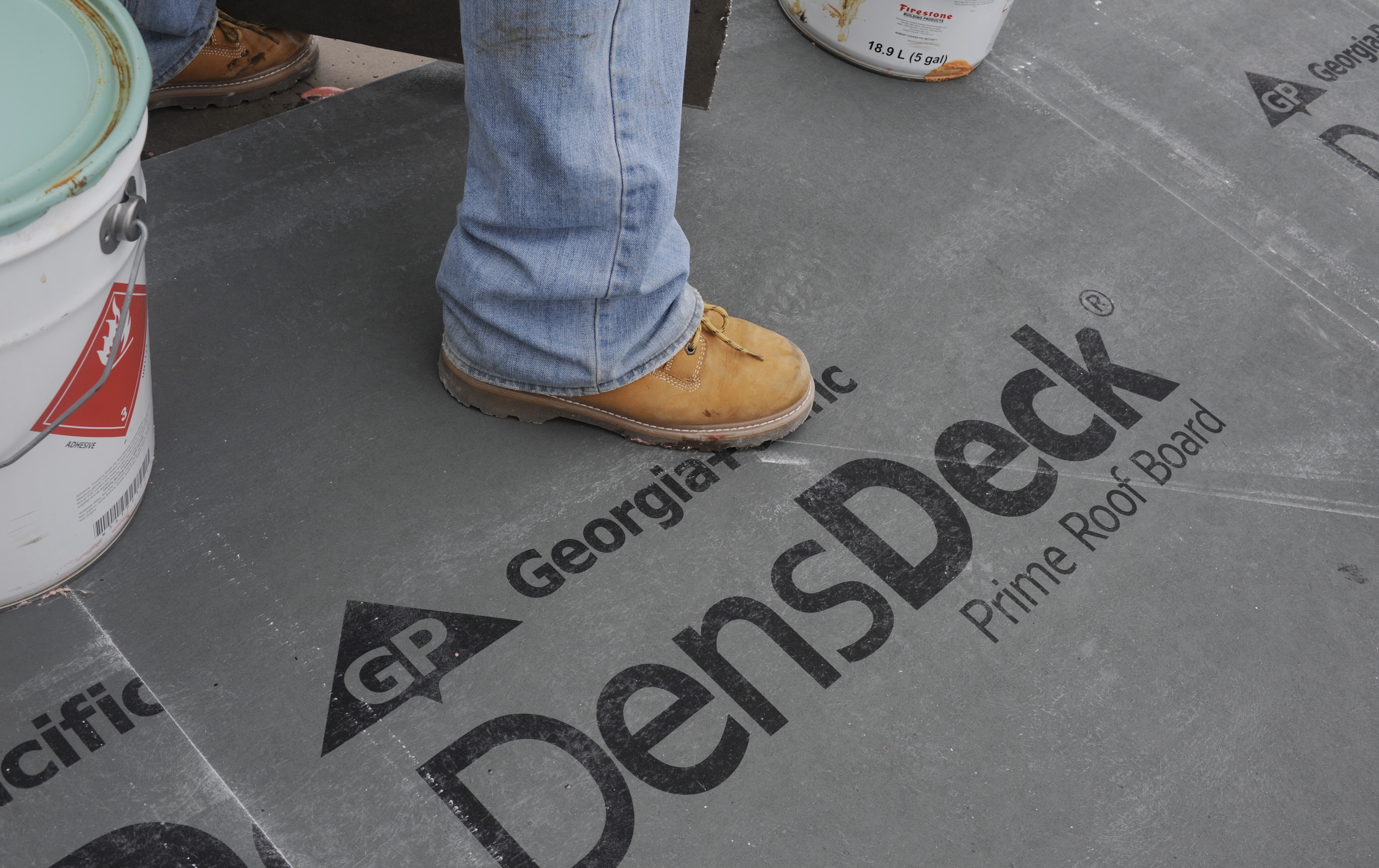Third-party testing results confirm that Georgia-Pacific Gypsum’s DensDeck Prime Roof Boards display puncture and impact resistance, protecting thermoplastic roofing membranes better than high-density polyisocyanurate (HD ISO) cover boards.
All types of commercial roofing membranes are susceptible to everyday punctures from a variety of sources. Rigid objects with sharp edges like dropped tools; heavy equipment; winds which blow branches and debris onto roofs; and frequent foot traffic for general maintenance and repair can cause punctures at any time, explains Todd Kuykendall, director of marketing and product management, Georgia-Pacific Gypsum. “DensDeck Prime cover boards support membranes so they can resist puncture damage, allowing them to do their job as the front-line protection of the roof assembly against water intrusion.”

Thermoplastic membranes tested in assemblies with 1/4-inch DensDeck Prime boards underneath were 83 percent more puncture resistant than membranes with 1/2-inch HD ISO or with no cover board at all, based on average calculations.
The independent ASTM D5635 puncture test results indicate that thermoplastic membranes do not puncture as easily when 1/4-inch DensDeck Prime Roof Boards are used as a cover board, as compared with HD ISO boards. Puncture-resistance testing conducted by Jim Koontz & Associates, July 21 to August 1, 2014, in its Hobbs, N.M. laboratory, according to ASTM D5635 standards. Assemblies included a base layer of 2 inches, 20-psi polyisocyanurate insulation; and configurations were covered with 45-mil thermoplastic polyolefin (TPO) or 48-mil polyvinyl chloride (PVC) membranes. The test method evaluates the maximum puncture load the samples can withstand, without allowing the passage of water when subjected to impact from a rigid object with sharp edges. Thermoplastic membranes tested in assemblies with 1/4-inch DensDeck Prime boards underneath were 83 percent more puncture resistant, on average, than membranes with 1/2-inch HD ISO or no cover board at all.
Durable and versatile DensDeck Prime roof boards can potentially save money for roofing contractors, building owners and facility managers by eliminating or reducing the need for costly repairs due to punctures during and after completion of the roof installation, Kuykendall adds, “In these puncture tests, HD ISO performed similar to no cover board at all, allowing thermoplastic membranes to puncture more easily.”
Thermoplastic membranes tested in assemblies with 1/4-inch DensDeck Prime boards underneath were 83 percent more puncture resistant than membranes with 1/2-inch HD ISO or with no cover board at all, based on average calculations.
In addition to puncture resistance testing, the independent company also conducted tests simulating the impact of hail in a variety of roofing scenarios—and the results were similar.

Performance of 1/4-inch DensDeck Prime roof board versus HD ISO or no cover board at 1.5- to 2.5-inch hail ball impacts. Assemblies in these tests with thermoplastic membranes and high-density ISO cover boards demonstrated 25 to 30 percent greater indentation than similar tests with DensDeck Prime roof boards.
FM 4473 (using NBS— National Bureau of Standards—23 standards) hail test results indicate that DensDeck Prime boards offer key benefits against hail damage versus HD ISO products. Hail testing (or impact resistance testing of rigid roofing materials by impacting with freezer ice balls) conducted by Jim Koontz & Associates July 21 to August 1, 2014, in its Hobbs, N.M. laboratory, according to FM 4473 (using NBS 23 standards). Based on average results using 1.5- to 2.5-inch freezer ice balls. Assemblies included a base layer of 2-inch 20-psi polyisocyanurate insulation; and configurations were covered with 45-mil thermoplastic polyolefin (TPO) or 48-mil polyvinyl chloride (PVC) membranes.
- Less likelihood of membrane damage — Assemblies with DensDeck Prime panels exhibited less indentation that stressed the membrane and can potentially result in membrane failure;
- More resilience during hail events — Assemblies with DensDeck Prime panels withstood larger hail sizes that may cause cover board fractures.
Performance of 1/4-inch DensDeck Prime roof board versus HD ISO or no cover board at 1.5- to 2.5-inch hail ball impacts. Assemblies in these tests with thermoplastic membranes and high-density ISO cover boards demonstrated 25 to 30 percent greater indentation than similar tests with DensDeck Prime roof boards.






Be the first to comment on "Georgia-Pacific Gypsum’s Durable Cover Board Outperforms High-density ISO in Puncture and Hail Testing"